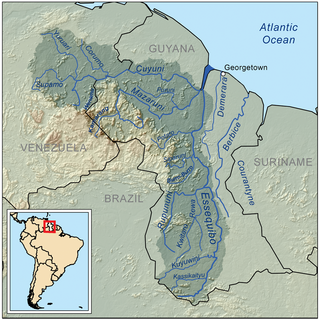Top Qs
Timeline
Chat
Perspective
Hogg Island, Guyana
Island in Guyana From Wikipedia, the free encyclopedia
Remove ads
Hogg Island, (sometimes referred to as Hog Island) is the largest island in the Essequibo River in Guyana. Covering an area of 59 km2 (23 sq mi), it lies in the Essequibo Islands–West Demerara region near the river’s mouth when it flows into the Atlantic Ocean. As per 2020 estimate, the island hosts approximately 250 people.
Originally named Varken Eiland ("Pig Island") by the Dutch in the 17th century, it hosts Guyana’s only historic brick windmill (built in 1768), restored and promoted as a tourism site. The primary economy centers on agriculture, and heritage tourism. The culture reflects a blend of rural Essequibo traditions and Dutch colonial legacy.
Remove ads
History
The island was controlled by the Dutch in the 17th century, when it was known as Varken Eiland ("Pig Island"), so named due to it being inhabited by a large number of wild hogs. Then in 1814 with the cessation of the Napoleonic Wars the British gained control of the Dutch colonies: Demerara, Berbice, and Essequibo, leaving the Dutch with Suriname until 1975. The British decided to keep the name of the island as "Hogg Island".[1][2]
Remove ads
Geography
Hogg is the largest island in the Essequibo River, the longest river in Guyana.[3] Covering an area of 59 km2 (23 sq mi), it lies about 5 km (3.1 mi) upstream of the river’s mouth when it flows into the Atlantic Ocean in the Essequibo Islands–West Demerara region.[4][5] The island experiences a tropical monsoon climate, with heavy seasonal rains and tidal water intrusion year-round. [6] The terrain is predominantly flat and low-lying, with extensive engineering works such as canals and spillways built in place to manage river flooding and drainage.[7]
Remove ads
Demographics and economy
An estimated 250 people lived in the island as of 2020, largely residing near the island’s center in small communities.[3] The primary economy centers on agriculture, and heritage tourism. The culture reflects a blend of rural Essequibo traditions and Dutch colonial legacy.[2] Recent infrastructure investments include drainage enhancements and soil conservation efforts.[8] A new Western Hogg Island Primary School opened in July 2024.[9]
Built in 1768, it hosts Guyana’s only historic brick windmill, restored and promoted as a tourism site.[5] It is located on the former plantation Lyksburg.[10][11] The National Trust of Guyana restored the mill in 2010, and it has been declared a national monument.[5][12]
References
Wikiwand - on
Seamless Wikipedia browsing. On steroids.
Remove ads


